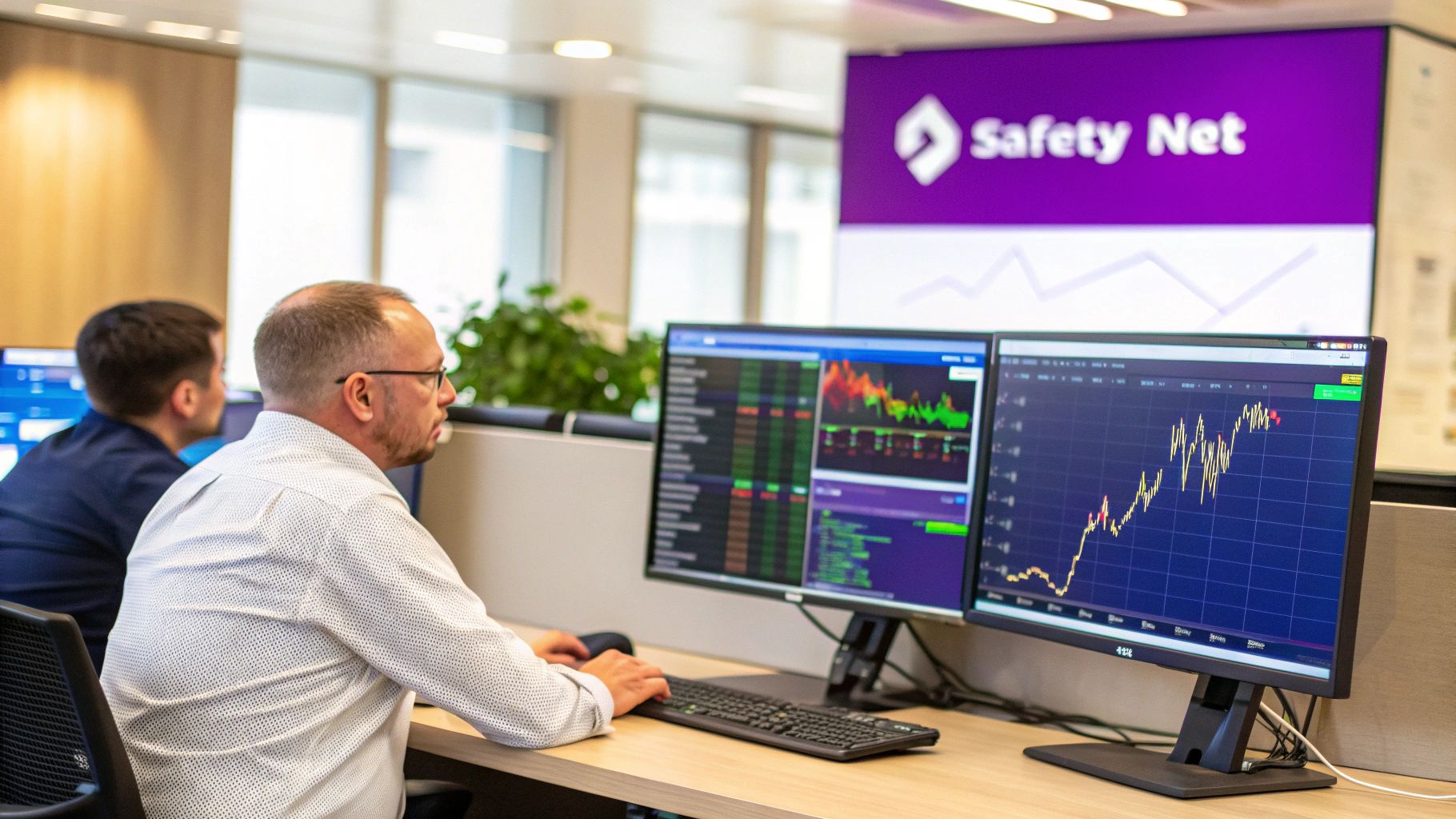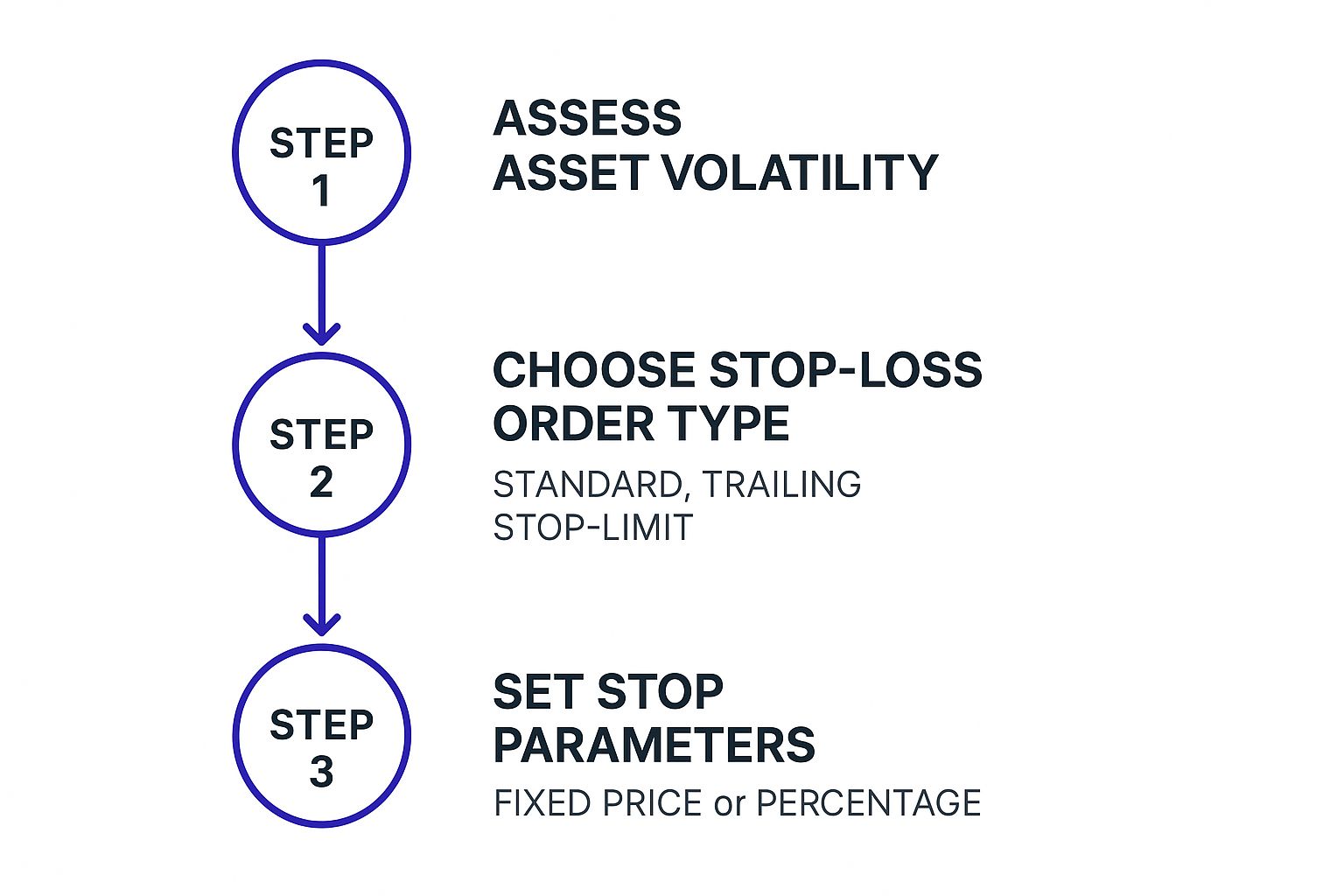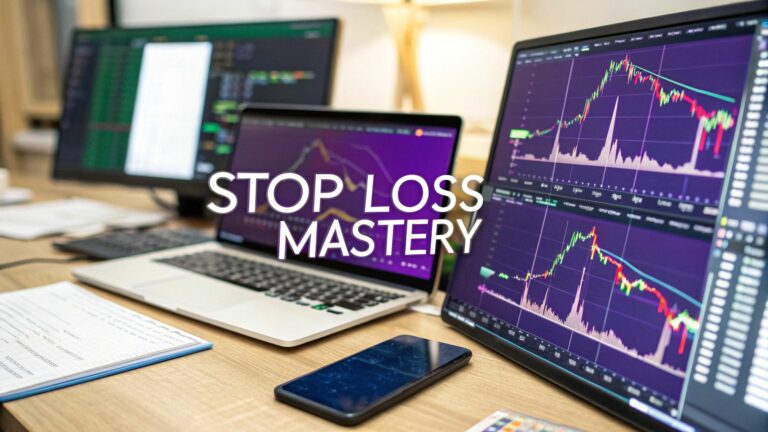Think of a stop loss as your financial safety net. It’s a pre-set order that automatically sells your asset if the price drops to a specific level you’ve determined, capping your potential losses before they get out of hand.
This isn’t just some fancy feature on a trading platform; it's a core piece of any disciplined trading plan. Its job is simple: protect your downside.
Let's say you buy a crypto asset at $100. If you set a stop loss at $90, your position automatically closes if the price falls to that mark. This simple action is what prevents a small, manageable loss from turning into a catastrophic one.

Why This Tool is Non-Negotiable
When markets get volatile—and they always do—emotions can wreck even the best trading strategy. Fear might push you to sell too early, while a bit of misplaced hope can convince you to hold a losing trade far too long. A stop loss doesn't have emotions; it just executes your plan.
A well-placed stop loss is the barrier between a calculated risk and a reckless gamble. It enforces discipline when your emotions might otherwise take over, ensuring you stick to your strategy even when the market is chaotic.
This is exactly why it's such a common practice among seasoned traders. In fact, some statistics show that around 88% of day traders use stop-loss orders as a fundamental part of their strategy. That kind of adoption speaks volumes about its value in managing risk.
The Foundation of Strategic Trading
Before you even think about more advanced techniques, you need to master setting a stop loss. This principle is universal, whether you're trading crypto or any other asset. You can explore different crypto assets on vTrader to see just how this tool can be applied across various market conditions.
For a quick reference, here's a rundown of how to place a standard stop-loss order on the vTrader platform.
Quick Guide to Setting a Stop Loss on vTrader
| Step | Action | Key Consideration |
|---|---|---|
| Open Order Ticket | Select the asset you are trading and navigate to the order placement window. | Make sure you're on the "Sell" or "Close Position" tab to set the stop correctly. |
| Select Order Type | Choose "Stop Loss" from the dropdown menu of order types available. | This will open up the specific price input field for your stop trigger. |
| Set Stop Price | Enter the exact price at which you want the order to execute. | This price should be based on your risk tolerance and market analysis, not a gut feeling. |
| Confirm Order | Review all the details of your order, including the asset, amount, and stop price. | Always double-check your inputs before confirming to avoid any costly mistakes. |
Think of this table as your pre-flight checklist. Following these steps ensures your safety net is properly in place before your trade takes off.
Choosing the Right Stop Loss for Your Trade
Picking the right stop loss isn’t a one-size-fits-all game. The order you choose really depends on what you're trading, what your goals are, and frankly, what the market is doing at that moment. It's like having a toolkit—you need to know when to grab the hammer and when you need a precision screwdriver.
The vTrader platform gives you a few different tools to work with. Getting a feel for the difference between a standard stop loss, a trailing stop, and a stop-limit order is key to protecting your capital.
The Standard Stop Loss: Your Reliable Default
The most common and straightforward option is the standard stop loss, often called a stop-market order. You simply set a specific price. If the market drops and hits that price, your position is automatically closed at the best available market price. Simple as that.
This is my go-to when I'm trading a more stable, blue-chip stock with clear support and resistance levels. Setting a standard stop just below a key support line gives me a clear, defined exit strategy. I know exactly what my maximum planned loss is on that trade.
Of course, keep in mind that transaction costs are part of the equation. It always pays to be familiar with the platform's cost structure, so take a look at vTrader's fee schedule to stay informed.
The Trailing Stop: Capturing Profits in a Trend
Now, for something a bit more dynamic. A trailing stop is built for markets on the move. Instead of a fixed price, you set a "trailing" amount—either as a percentage or a specific dollar value below the current market price.
Here's where it gets clever. As the asset's price climbs, your stop loss automatically "trails" it, moving up and locking in your profits along the way. If the price dips, the stop stays put. It only triggers if the price reverses by the amount you specified.
Imagine you've just bought into a volatile tech stock you think is about to pop. A standard stop loss would get you out, but it won't do anything to protect your gains. A trailing stop rides the wave up with you, giving you breathing room while protecting your profits from a sudden reversal.
This quick visual breaks down the decision process.

As you can see, your choice really boils down to the asset's behavior and what you're trying to achieve with the trade.
Research has even shown that trailing stops often provide more flexibility than fixed rules, especially when markets are choppy. Their real power is in their adaptive nature, though their effectiveness hinges on setting the right percentage.
The Stop-Limit Order: Precision Over Speed
Finally, we have the stop-limit order. This is a more advanced, two-part order that gives you granular control over your exit price. It has two components:
- The Stop Price: This is the trigger. Once the market hits this price, your order becomes active.
- The Limit Price: This is the exact price (or better) you're willing to sell at.
When the stop price is hit, it doesn't trigger a market sell. Instead, it places a limit order to sell at your limit price.
This is a crucial distinction. A stop-limit order is your defense against slippage—that frustrating gap between the price you expected and the price you got. During a flash crash, slippage can be brutal. The trade-off? If the market gaps down hard, flying right past your limit price, your order might not get filled at all, leaving you holding the bag.
Putting Stop Loss Orders to Work in vTrader
Alright, enough theory. Let’s jump into the vTrader platform and see how this all works in practice. The interface is designed to be pretty intuitive, so even if this is your first time setting a stop loss, you’ll find it’s a smooth process. We'll go through it click-by-click.
By the way, if you’re trading more than just standard crypto or stocks, it really helps to have a handle on the instruments themselves. Understanding the mechanics of things like how stock options work gives you a huge leg up when you're setting up complex orders.
With that, let's pull up the vTrader order ticket.
Finding Your Way Around the Order Ticket
Once you've picked your asset and are ready to pull the trigger, the order ticket is where the magic happens. Look for a toggle or checkbox labeled "Add Stop Loss & Take Profit." This is your starting point.
Flipping this switch expands the ticket, revealing the fields where you’ll lay out your exit plan. It's essentially telling the platform you want to attach protective orders to your trade, automating your risk management from the get-go.
Setting a Classic Stop Loss
For a standard stop loss, it couldn't be simpler. Once you've enabled the feature, you'll see a field for your "Stop Price." This is where you punch in the exact price that signals "get me out."
Let's imagine you buy Bitcoin at $60,000. You've decided you're not willing to lose more than $1,500 on this trade. In that case, you’d set your stop price to $58,500. The moment the market touches that price, vTrader will automatically fire off a market order to sell your position and cap your loss.
A Quick Pro-Tip: Try to avoid setting your stop loss right on a big, round number like $58,000. These are psychological levels where tons of traders place their orders, and they can become targets for stop-hunts. Setting it just a bit off, say at $58,040, can sometimes keep you from getting knocked out of a good trade prematurely.
This is the bread and butter of disciplined trading. For a deeper dive into these kinds of core principles, the vTrader Academy is packed with great material to build on these skills.
How to Configure a Trailing Stop
A trailing stop is your best friend in a strong trend, and setting one up is just as easy. Instead of a fixed price, you'll be defining a "Trail Amount" or "Trailing Distance." You usually have two options here:
- By Percentage: You could set a 5% trail. This means your stop will always sit 5% below the highest price your trade has reached.
- By Price Distance: Or, you could set a $2,000 trail on your Bitcoin trade. Your stop will then constantly adjust to stay exactly $2,000 below the peak price.
After you've entered your parameters and given everything a final once-over, just hit confirm. Your stop loss is now active and on duty, guarding your capital so you can step away from the screen without worry.
Where to Place Your Stop Loss for Better Results

Knowing how to set a stop loss is just the first step. The real art—what separates the consistently profitable traders from everyone else—is knowing exactly where to place it. An arbitrary stop is just a shot in the dark, but a strategically placed one is your first line of defense.
Let's get into the nitty-gritty of placement. The goal is to find that sweet spot: giving your trade enough breathing room to ride out normal market chatter without exposing your capital to a catastrophic hit. It's a tricky balance, but thankfully, there are some proven methods to get you there.
Anchoring Your Stop to Technical Levels
One of the most battle-tested approaches is to anchor your stop loss to key technical levels on a chart. These are the price zones where the market has shown a strong reaction in the past, hinting at a heavy concentration of buyers or sellers.
The classic move here is to use support levels. Think of support as a price floor that an asset has trouble breaking through. By placing your stop just below a major support zone, you're essentially saying, "If the price breaks this floor, a bigger drop is likely, and I'm out."
On the flip side, if you're shorting an asset, you'd place your stop just above a key resistance level—a price ceiling the asset can't seem to punch through.
Trader's Insight: This works because it's a self-fulfilling prophecy of sorts. Hordes of other traders are watching the exact same levels. A decisive break of support can trigger a cascade of selling, validating your decision to exit.
But there’s a catch. Because these spots are so obvious, they can become prime targets for "stop hunting," where big-money players deliberately push the price just enough to trigger all those clustered stop orders.
Using the Average True Range (ATR)
For a more dynamic approach that adapts to market conditions, turn to a volatility indicator like the Average True Range (ATR). The ATR gives you a feel for an asset's typical price movement over a set period, which is incredibly useful for setting a stop that isn't too tight or too loose.
Here’s how you can put it into practice:
- Find the ATR Value: Look up the current ATR for your asset on your preferred timeframe. For something as volatile as Bitcoin, you can see these metrics right on the vTrader BTC currency page.
- Apply a Multiplier: Multiply the ATR value by a factor, usually between 1.5 and 3, depending on how much risk you're comfortable with. A lower multiplier means a tighter stop.
- Set Your Price: For a long position, subtract this calculated value from your entry price. For a short, add it.
This technique helps you set a stop that truly respects the asset’s personality, keeping you in the game during normal market swings instead of getting shaken out prematurely.
Deciding which stop-loss method to use often comes down to the specific asset you're trading and your personal strategy. Here’s a quick rundown to help you compare.
Comparison of Stop Loss Placement Methods
| Method | Best For | Pros | Cons |
|---|---|---|---|
| Support/Resistance | Chart-based traders, swing trading. | Easy to identify on charts; based on historical price action. | Obvious placement can attract "stop hunting." |
| Average True Range (ATR) | Volatile markets, day trading. | Adapts to current market volatility; less arbitrary. | Requires an indicator; can be too wide in choppy markets. |
| Percentage-Based | Long-term investors, portfolio management. | Simple to calculate; enforces consistent risk per trade. | Ignores volatility and market structure. |
| Moving Averages | Trend-following strategies. | Dynamic and follows the trend; acts as a trailing stop. | Can trigger too early in ranging markets. |
Each of these methods has its place. The key is to find the one that aligns with your trading style and test it until you're confident in its application.
Sidestepping Common Placement Traps
It's also critical to remember that large clusters of stop-loss orders can literally move the market. In fact, research shows that currency trends often accelerate dramatically when they hit prices where many stops are grouped, creating powerful price cascades.
To avoid getting caught in one of these traps, never place your stop at an obvious, round number. Setting a stop precisely at $50.00 is practically begging for trouble. A more nuanced price like $49.87 is far less likely to be a magnet for stop-hunting algorithms. Always aim for strategic, not just convenient.
Common Stop Loss Mistakes and How to Avoid Them

Even the sharpest tools in a trader's arsenal can backfire if you don't know how to handle them, and the stop-loss is a prime example. I’ve seen it countless times: a poorly placed stop can be even worse than having no stop at all. It quickly turns your safety net into a guaranteed loss trigger.
Getting this right means understanding where most traders go wrong.
One of the biggest blunders is setting your stop-loss way too tight. It’s a classic rookie move, usually driven by a paralyzing fear of taking even a small loss. You find a great setup, jump in, and then slap a stop just a few cents below your entry. What happens next is painfully predictable: the market does its normal dance, a brief dip takes you out, and then you watch helplessly as the price rockets up without you.
Giving Your Trades Room to Breathe
You have to accept that markets don't move in straight lines. They fluctuate. A smart stop-loss sits outside the range of this everyday market “noise.”
A great way to do this is by using a tool like the Average True Range (ATR). It helps you calculate a stop level based on the asset's actual, recent volatility. This gives your trade the space it needs to move naturally without getting stopped out on a meaningless flicker.
On the flip side, another common mistake is setting your stop far too wide. This happens when a trader is so terrified of getting shaken out that they place their stop at a point that represents a catastrophic loss. Doing this completely defeats the purpose of risk management. Your stop is there to protect your capital, not just to make you feel like you have one.
The single most destructive mistake, however, is moving your stop loss further away when a trade starts going against you. This isn’t a strategy; it’s just hope. It turns a defined, manageable risk into an open-ended gamble.
The second you drag that stop-loss down to give a losing position more “room,” you’ve abandoned your trading plan and thrown discipline out the window.
To stop yourself from making this emotional error, drill these rules into your head:
- Your initial stop is sacred. Once you've set it based on solid analysis, it doesn't move—at least not further away from your entry.
- Only adjust stops in your favor. Trail your stop up to lock in profits as a trade moves your way. Never, ever move it down to increase your potential loss.
- Get comfortable with small losses. A planned, small loss is just the cost of doing business in the markets. Trying to avoid it almost always leads to a much, much bigger one.
Common Questions About Stop Losses
Even after you get the hang of setting them, a few tricky questions about stop losses always seem to pop up. Let's walk through some of the most common ones to clear up any confusion and help you use this powerful tool with more confidence.
Does a Stop Loss Guarantee My Exit Price?
Not always, and this is a critical distinction every trader needs to understand. When your trigger price gets hit, a standard stop loss becomes a market order. In a fast-moving or volatile market, the price can "gap" down past your stop before your order actually gets filled.
This gap leads to something called slippage, which just means your exit price ends up being lower than your intended stop price. It can be frustrating, for sure, but it's a real part of trading, especially in chaotic or thinly-traded markets. A stop-limit order can help by setting a price floor, but it introduces a new risk: if the price plummets right past your limit, your order might not get filled at all.
How Often Should I Adjust My Stop Loss?
Here's a simple rule, and it's non-negotiable: only move a stop loss in the direction of a winning trade. The entire point is to protect your capital and lock in profits—which is exactly what a trailing stop does for you automatically.
Never, ever move your stop further away to give a losing trade "more room to breathe." That’s one of the quickest ways to blow up an account. It turns a disciplined risk management tactic into an emotional gamble based on nothing but hope. For most traders, a "set it and forget it" approach based on your initial, clear-headed analysis is the most disciplined path forward.
Your stop loss is your line in the sand. Once it's drawn, it should only move forward to protect profits, never backward to accommodate a loss.
What Is Stop Hunting and How Can I Avoid It?
Stop hunting is a hot topic. It's the idea that large market players intentionally push prices toward obvious technical levels—like major support or big round numbers—to trigger the clusters of stop orders they know are waiting there. This kicks off a cascade of selling, which gives them the liquidity they need to fill their own massive orders.
So, how do you mitigate this risk?
- Avoid the obvious spots. Don't place your stop exactly on a major support line or a round number like $50.00. It's just too predictable.
- Give it some cushion. Build in a buffer by placing your stop slightly below that key level. Using a volatility indicator like the Average True Range (ATR) can help you figure out a logical buffer zone based on the asset's recent behavior.
By placing your stop in a less crowded, more strategic location, you lower the odds of getting shaken out by a quick, manufactured price spike.
For more detailed questions about how the platform works, you can always check out the answers in our comprehensive vTrader FAQ section.
Ready to trade smarter, not harder? With vTrader, you get commission-free trading, advanced tools, and the security you need to protect your portfolio. Sign up today and start setting stop losses like a pro!

Steve Gregory is a lawyer in the United States who specializes in licensing for cryptocurrency companies and products. Steve began his career as an attorney in 2015 but made the switch to working in cryptocurrency full time shortly after joining the original team at Gemini Trust Company, an early cryptocurrency exchange based in New York City. Steve then joined CEX.io and was able to launch their regulated US-based cryptocurrency. Steve then went on to become the CEO at currency.com when he ran for four years and was able to lead currency.com to being fully acquired in 2025.


